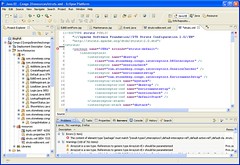So, 3 days I’ve had my iPhone now, and I tell ya, it’s hard to put down. So hard I’ve had a hard time finding time to write to the blog about how much I’m enjoying it.
Here’s a couple highlights of my first, realistically, 2.25 days with the phone. It’s a black 16gig iPhone 3G, just to make sure everyone is on board.
- Within two hours of powering up the phone (20 minutes of which I was driving), I had successfully attached to my SSL IMAP server at home and was reading my inbox, connected to my gmail account, AND attached to the Exchange server at work. All quite seamlessly. The accounts play well with each other, I can set up Fetch or manual updates (so cute having the phone next to me go “chime!” when I get new mail, but for busy inboxes, gets old fast).
- Getting my Contacts synced from Google Contacts was a little trickier, but iTunes for windows just BARELY had enough functionality to make this possible. But, it sure was nice getting all 400 some odd contacts back into my address book.
- The iTunes Appstore is wonderful. Many good applications available, and it’s trivial to install them either via iTunes, or directly via the appstore link on the phone.
- It’s very hard to keep reminding myself this is a 3G, unlimited Data plan unit. Once I got past that mental block I tuned into RadioParadise, hit the streaming 3G feed, and listening to the station all the way home. That’s a 45 minute driving commute, RP didn’t burp once, feeding music to a moving car in Boston at 128kbps. Just too sexy for words.
- I’ve ordered a simple skin from Gelaskins – I’m constantly afraid of scratching the phone – having some sort of barrier to keep it’s gleaming body away from my pocket change is a must.
- The keyboard took some getting used to – but with Apple’s smart fingertip placement, AND a very intelligent replacement algorithm that ‘just plain works’ (none of the ‘did you mean This?’ nonsense. 99% of the time it guesses right, and you don’t have to do anything, it just replaces the text for you, after letting you know via a very nice animation that it was doing so).
In short. I love it. I’ve named it Speicus.
More kvelling later.






 According to
According to